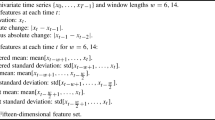Abstract
In this paper, we investigate the Bahadur type representation of a nonparametric expected shortfall estimator for \(\alpha \)-mixing financial losses. Based on the Bahadur type representation, we further establish the Berry–Esseen bound of the nonparametric expected shortfall estimator. It is shown that the optimal rate can achieve nearly \(O(n^{-1/8})\) under some appropriate conditions. We also carry out some numerical simulations and a real data example to support our theoretical results based on finite samples.








Similar content being viewed by others
References
Artzner P, Delbaen F, Eber JM, Heath D (1999) Coherent measures of risk. Mathem Financ 9(3):203–228
Chen SX (2008) Nonparametric estimation of expected shortfall. J Financ Econometr 6:87–107
Doukhan P (1994) Mixing properties and examples, vol 85. Lecture notes in statistics. Springer, Berlin
Embrechts P, Klüeppelberg C, Mikosch T (1997) Modeling extremal events for insurance and finance. Springer, Berlin
Frey R, McNeil AJ (2002) VaR and expected shortfall in portfolios of dependent credit risks: conceptual and practical insights. J Bank Financ 26(7):1317–1334
Gorodeskii VV (1977) On the strong mixing property for linear sequences. Theory Probab Appl 22:411–413
Mausser H, Rosen D (1998) Beyond VaR: from measuring risk to managing risk. Algo Res Quart 1(2):5–20
Mckay R, Keefer TE (1996) VaR is a dangerous technique. Corporate Finance, Searching for Systems Integration Supplement, September
Pollard D (1984) Convergence of stochastic processes. Springer, Berlin
Roussas GG, Ioannides D (1987) Moment inequalities for mixing sequences of random variables. Stoch Anal Appl 5(1):60–120
Scaillet O (2004) Nonparametric estimation and sensitivity analysis of expected shortfall. Mathem Financ 14:115–129
Withers CS (1981) Conditions for linear processes to be strong-mixing. Zeitschrift Für Wahrscheinlichkeitstheorie Und Verwandte Gebiete 57(4):477–480
Wu Y, Yu W, Balakrishnan N, Wang XJ (2022) Nonparametric estimation of expected shortfall via Bahadur-type representation and Berry-Esséen bounds. J Stat Comput Simul 92(3):544–566
Yang SC (2000) Moment bounds for strong mixing sequences and their application. J Mathem Res Exposit 20(3):349–359
Yang SC (2003) Uniformly asymptotic normality of the regression weighted estimator for negatively associated samples. Stat Probab Lett 62(2):101–110
Yang SC (2007) Maximal moment inequality for partial sums of strong mixing sequences and application. Acta Mathem Sin Engl Ser 23(6):1013–1024
Yang SC, Li YM (2006) Uniformly asymptotic normality of the regression weighted estimator for \(\alpha \)-mixing samples. Acta Mathem Sin Chin Ser 49:1163–1170
Funding
The study was supported by the National Social Science Foundation of China (22BTJ059).
Author information
Authors and Affiliations
Corresponding author
Additional information
Publisher's Note
Springer Nature remains neutral with regard to jurisdictional claims in published maps and institutional affiliations.
Appendix A
Appendix A
To prove our main results, the following lemmas are indispensable. The first one can be found in Roussas and Ioannides (1987).
Lemma A.1
Suppose that \(\xi \) and \(\eta \) are \(\mathcal {F}_{1}^{k}\)-measurable and \(\mathcal {F}_{k+n}^{\infty }\)-measurable random variables, respectively. If \(E|\xi |^{p}<\infty \), \(E|\eta |^{q}<\infty \) for some \(p,q,t>1\) with \(p^{-1}+q^{-1}+t^{-1}=1\). Then
The next lemma is Theorem 2.1 of Yang (2007).
Lemma A.2
Let \(r>2,\eta >0\), and \(\{e_{i},i\ge 1\}\) be a sequence of \(\alpha \)-mixing random variables with \(Ee_{i}=0\) and \(E|e_{i}|^{r+\eta }<\infty \) for each \(i\ge 1\). Suppose that \(\alpha (n)=O(n^{-\lambda })\) for some \(\lambda >r(r+\eta )/(2\eta )\). Then for any \(\epsilon >0\), there exists a positive constant C depending only on \(\varepsilon ,r,\eta \), and \(\lambda \) such that for each \(n\ge 1\),
The following lemma comes from Yang (2000).
Lemma A.3
Let \(\{a_{i},i\ge 1\}\) be a real sequence and \(\{Y_{i},i\ge 1\}\) be a sequence of zero mean \(\alpha \)-mixing random variables with \(E|Y_{i}|^{2+\delta }<\infty \) for some \(\delta >0\). Then for all \(n\ge 1\),
The following lemma can be seen in Yang and Li (2006).
Lemma A.4
Let p and q be positive integers and \(\{e_{i},i\ge 1\}\) be a sequence of \(\alpha \)-mixing random variables. Set \(\eta _{l}=:\sum _{j=(l-1)(p+q)+1}^{(l-1)(p+q)+p}e_{j}, 1\le l\le k\). Assume that \(r>0\) and \(s>0\) such that \(1/r+1/s=1\). Then there exists some positive constant C such that for any \(t\in \mathbb {R}\),
The last one can be found in Yang (2003) for instance.
Lemma A.5
Suppose that \(\{\zeta _{n},n\ge 1\}\) and \(\{\eta _{n},n\ge 1\}\) are two sequences of random variables, \(\{\gamma _{n},n\ge 1\}\) is a positive constant sequence with \(\gamma _{n}\rightarrow 0\) as \(n\rightarrow \infty \). If
the for any \(\varepsilon >0\),
Rights and permissions
Springer Nature or its licensor (e.g. a society or other partner) holds exclusive rights to this article under a publishing agreement with the author(s) or other rightsholder(s); author self-archiving of the accepted manuscript version of this article is solely governed by the terms of such publishing agreement and applicable law.
About this article
Cite this article
Wang, X., Wu, Y. & Wang, W. Nonparametric estimation of expected shortfall for α-mixing financial losses. Comput Stat (2023). https://doi.org/10.1007/s00180-023-01434-5
Received:
Accepted:
Published:
DOI: https://doi.org/10.1007/s00180-023-01434-5




